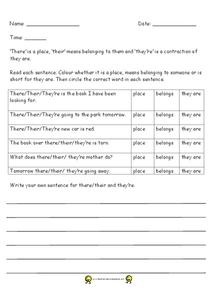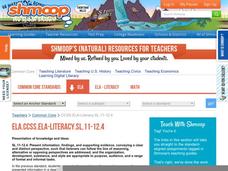Curated OER
The most commonly misspelled words in English
Ninth graders examine the different misspelled words in the English language. In this English lesson plan, 9th graders read an article and answer guided reading questions. Students write an email to their teacher about what they have read.
BW Walch
Daily Warm-Ups: Grammar and Usage
If grammar practice is anywhere in your curriculum, you must check out an extensive collection of warm-up activities for language arts! Each page focuses on a different concept, from parts of speech to verbals, and provides review...
Curated OER
Making Words
Third graders spell words and define homophone. In this making words lesson, 3rd graders decipher words from letter strips in an effort to identify the "secret word". Students use a set of letters to spell different words.
Goodwill Community Foundation, Inc.
Saying Hello: Common Greetings in Spanish
The first thing Spanish learners need to know is how to say hello! An interactive resource guides beginners into basic Spanish greetings with audio prompts and self-assessment checklists.
Curated OER
There, Their, and They're
In this word usage worksheet, students review example sentences for the correct usage of there/their/they're. Students complete 3 activities to help them identify the correct word usage.
Curated OER
There, Their, and They're
In this grammar activity worksheet, students read the sentences and color in the section to illustrate which there/their/they're to use. Students then circle the correct form. Students finish by writing a sentence for each form of the word.
Curated OER
Word Confusions: Lesson Eleven
A very basic presentation about homonyms, this slide show might be too short for your grammar lecture. However, if you pair it with the other presentations to which it is linked, you might be able to implement it more successfully. The...
Curated OER
Grammar Worksheets: Apostrophe Errors
Do your young grammarians confuse their it’s and its? Their they’re, there, and their? You’re lucky because help is here! After a brief but succinct explanation of the proper use of apostrophes and homophones, learners show what they've...
Curated OER
Classroom Objects
A word and picture comprehension worksheet is here for your ESL students. They analyze seven pictures that depict common classroom objects, and match the pictures to the words that describe them.
Noyce Foundation
Rabbit Costumes
How many rabbit costumes can be made? This is the focus question of an activity that requires scholars to use multiplication and division of fractions to solve a real-world problem. They determine the amount of fabric necessary for eight...
Curated OER
Speak Write! Understanding the Hidden Meaning of Words
Young scholars investigate connotation and denotation as a basis for greater examining of language. They identify the literal meaning of words and explore the greater implications and impact of word usage.
Curated OER
Correct the Homophones
Homophones are tricky! Build confidence in your young grammarians by giving them this practice sheet. There are 12 sentences shown that use one word incorrectly. Your learner must identify the homophone and rewrite the sentence using the...
Judicial Learning Center
Law and the Rule of Law
We hear a lot about the importance of the rule of law, but most people do not really know what those words mean. The lesson is a webpage that defines the rule of law, explains why it is important in a democratic society and provides...
Curated OER
Fourth Grade English: Their, They're, and There
While this lesson provides a great idea for an exploration, it is incomplete. Learners are asked to identify the differences between their, they're and there, and discuss homonyms, but there are not activity descriptions. This lesson...
Curated OER
Sayings Quiz: Truth
In this English idioms and sayings activity, learners complete sentenecs by interpreting English sayings.
Curated OER
It's All an Allusion: Identifying Allusions, in Literature and in Life
To allude, or not to allude, that is the question: whether ‘tis better to make a reference and engage your audience or risk confusing them or sounding dated. After reading an article about, and loaded with allusions, class members take a...
Curated OER
Famous Sayings: Sentence Writing
For this famous sayings worksheet, students read sayings, then write a 1 sentences answer telling what they think the saying means. Students label their sentences as simple, compound or complex.
Shmoop
ELA.CCSS.ELA-Literacy.SL.11-12.4
Study allusions with a research and presentation project. Pupils are assigned a specific allusion, the phoenix for example. They research the origins, compose a summary, explain the concept, and explore this allusion within various...
Curated OER
Problem Solving in British Pounds
Compare the cost of four common food items at the grocery store! The value of these objects is represented in British pounds, but you could cross this off if it's too confusing for your elementary learners.
Curated OER
Homophones: Are/Our, There/Their/They're
In this homonyms/homophones activity, students read 10 illustrated sentences and complete them with the correct word: our, are, there, their, they're.
Curated OER
Punctuation 2: Other than Commas
Thoroughly cover the nuances of apostrophes, quotation marks, dashes, hyphens, colons, and semi-colons. Intended for higher-level English classes, the examples given pertain to tricky rules and formal language. There are no animations or...
Curated OER
Less vs. Fewer
When should you use less, and when should you use fewer? Straighten out this dilemma with a helpful resource about using less vs. fewer based on sentence context clues. After reading detailed instructions and examples, young learners...
K12 Reader
The Important Apostrophe: Their, They’re, and There
They're going to be there with their family. Class members practice using and identifying the correct use of they're, there, and their with a skills practice activity. The top half of the activity gives brief background information on...
K12 Reader
The Important Apostrophe: You're and Your
You're going to love a instructional activity that teaches your class the difference between you're and your. Learners read a brief introduction explaining the two words and practice identifying the correct uses. Then, they read...
Other popular searches
- Commonly Confused Words Game
- Spelling Easily Confused Words
- Easily Confused Words Stress
- 56 Easily Confused Words

























